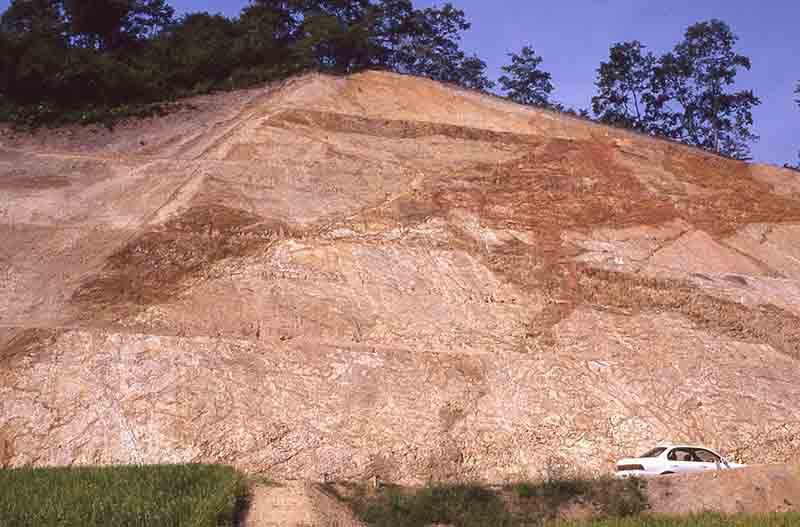Bulletin of the Geological Survey of Japan Top Page
Bulletin of the Geological Survey of Japan Vol.67 No.2 (2016)
Cover photograph | Table of Contents | Abstract
Cover photograph
Outcrop of weathered magnetite-series granite in the Sanin belt, Shimane Prefecture
K-feldspars in granites are often pink to reddish brown in color, particularly those in Precambrian granites, which belong to the magnetite-series. Stain is considered to be caused by powdery hematite and limonite resulted from oxidation of primary magnetite in the granite.
In Japan, Mannari stone from Okayama City is well-known and commercially popular colored granite. Similar granite from Hiroshima Prefecture is used for the Diet Building of Japan. Occurring in the Sanyo ilmenite-series granite belt, they don't contain magnetite and are Late Cretaceous in age. On the other hand, granite intruded into the Ryoke metamorphic rocks has no pink coloration. Coloration of K-feldspar in granites from Japan needs to be carefully studied.
The picture above is strongly colored weathered granite of the magnetite series in the Sanin belt, middle Shimane Prefecture. The intense weathering of the magnetite-rich pink granite resulted in the reddish brown color of the outcrop, which cannot be seen in the Sanyo belt or Ryoke belt.
(Photograph and Caption by Shunso Ishihara)
Table of Contents
All the pages PDF : 67_02_full.pdf [5.4MB]
| Title | Author | |
|---|---|---|
| Article | ||
| Geochemical variation of the Late Cretaceous-Paleogene granitoids across the Ehime-Hiroshima-Shimane transect, Japan |
Shunso Ishihara and Tetsuji Ohno (p41-58)
|
67_02_01.pdf [4MB] |
| Report | ||
| Zircon U-Pb dating by SHRIMP: sample preparation procedure and result of reference material measurements |
Daisuke Araoka, Yoshiaki Kon and Terumi Ejima (p59-65)
|
67_02_02.pdf [640kB] |
Abstract
Geochemical variation of the Late Cretaceous-Paleogene granitoids across the Ehime-Hiroshima-Shimane transect, Japan
Shunso Ishihara and Tetsuji Ohno
Geochemical and geomagnetic character of the Late Cretaceous-Paleogene granitic batholith was examined at N-S transect across the city of Hiroshima. The granitoids are mostly biotite granite in composition, but granodiorite predominates in the Takanawa Peninsula. Their magnetic susceptibility is the highest in the Sanin belt, but becomes lower of the ilmenite-series to the south and lowest in the southernmost Ryoke belt. The granitoids are most sodic in the Sanin belt and potassic in the Sanyo and Ryoke belts, which may reflect igneous and sedimentary source rocks, respectively. The alumina saturation index (A/CNK) is above 1.0, i.e., peraluminous, but never exceeding 1.1 for S-type granite. Rb and Pb replacing K are the least in the Sanin belt but the highest in the Ryoke and southern Sanyo belts.
High-Sr granitoids and adakite of the northern Kyushu and the Kinki district were not found in the studied regions. Zircon saturation temperatures in the average of the studied granitoids are the highest of 753oC in the Ryoke belt, because granodiorite predominates here.
Zircon U-Pb dating by SHRIMP: sample preparation procedure and result of reference material measurements
Daisuke Araoka, Yoshiaki Kon and Terumi Ejima
U-Pb zircon dating is a useful method for determining precise ages of solidification of igneous rocks within a wide range of geological time scale. Thus, we set up SHRIMP (Sensitive High Resolution Ion MicroProbe) U-Pb zircon dating method and sample preparation procedure for SHRIMP analysis in a laboratory of the Geological Survey of Japan, AIST. First, zircons in the samples were separated effectively using SHLFRAG Lab (high voltage pulse power fragmentation), heavy liquid, and so on. The separated zircons were mounted on resin followed by polishing, Au-coating, and cathodoluminescence observation. Then, SHRIMP U-Pb ages of zircon reference materials (R33, OG1, and 91500) with Paleozoic to Eoarchean Era were determined. All dating results were corresponding to the reference ages within the analytical error, indicating that accurate SHRIMP U-Pb zircon dating could be established in AIST.
Geological Survey of Japan, AIST
- About GSJ
- Our Activities
- Purchase guide
-
Publications and Database
- information
- Bulletin of the Geological Survey of Japan
- bull2025(Vol.76)
- bull2024(Vol.75)
- bull2023(Vol.74)
- bull2022(Vol.73)
- bull2021(Vol.72)
- bull2020(Vol.71)
- bull2019(Vol.70)
- bull2018(Vol.69)
- bull2017(Vol.68)
- bull2016(Vol.67)
- bull2015(Vol.66)
- bull2014(Vol.65)
- bull2013(Vol.64)
- bull2012(Vol.63)
- bull2011(Vol.62)
- bull2010(Vol.61)
- bull2009(Vol.60)
- bull2008(Vol.59)
- bull2007(Vol.58)
- bull2006(Vol.57)
- bull2005(Vol.56)
- bull2004(Vol.55)
- bull2003(Vol.54)
- bull2002(Vol.53)
- bull2001(Vol.52)
- Bulletin of the Geological Survey of Japan(old)
- Annual Report on Active Fault and Paleoearthquake Researches
- Reports, Geological Survey of Japan
- CCOP-GSJ Groundwater Project Report
- CCOP Technical Bulletin
- Cruise Report
- Geological Hazards
- Learning and Education
- GSJ Database Collection
- Collection of links


